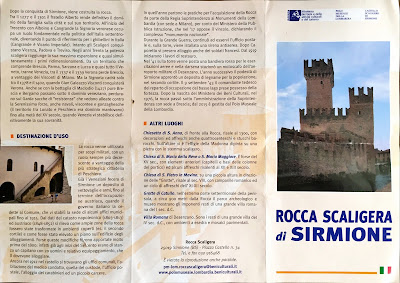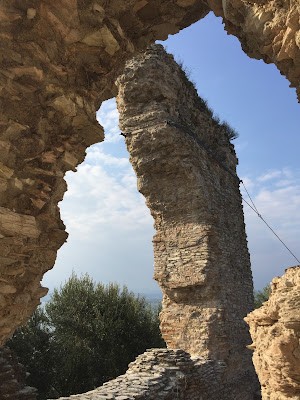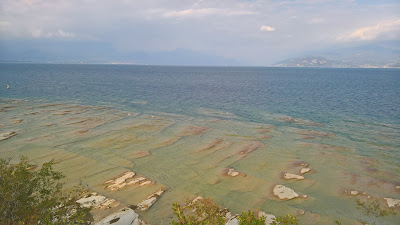

Besides the Perché Bergamo?, the next question locals usually ask is if we’ve been to Sirmione or Crespi D’Adda. For almost a year we’ve had to say no. But no more because finally this weekend the timing was right and we went to both of these iconic sites.
Aside: It is possible to take public transportation to both of these sites: a train and bus combo to Sirmione and a bus to Crespi D’Adda. Instead, we rented a car for the weekend and used that to visit. Sirmione is a little over 1 hour west of Bergamo, and Crespi D’Adda is about 25 minutes southwest of Bergamo. We found parking in Crespi relatively easily. In Sirmione, if you are lucky and the town isn’t busy, you can park just south of the historic center in the large pay lot. If not, you’ll have to park further south along one of the many pay lots and hoof it to the center.
Sirmione
Geographically, Sirmione is a peninsula – a long skinny finger – jutting into Lago di Garda, running north south. About midway up the peninsula, is the south entrance of the old city, guarded by the photogenic Castello Scaligero. After the castle and continuing north, you pass through shops, restaurants, and large hotels until you reach the Grotte di Catullo, which is the ruins of a large Roman villa at the north end of the peninsula. Along the journey, you are never more than a few steps from the lake.
The main attractions for us were the Castello and the Grotte di Catullo. Spas which take advantage of the warm, mineral-rich waters that come out of the natural hot springs of the peninsula are a popular draw as well in Sirmione, but not for us today. We did see a few bathers taking in the “waters” in makeshift spa pools built up of rocks along the shore and profiting from excess hot water released into the lake.
We spent about 1 hour in the Castello, walked a bit, ate lunch (Ristorante Il Girasole), and then tackled the Grotte in the afternoon, a full day.
Some points:
- The name grotte in the Grotte di Catullo is not because it really is a grotto, but rather it looked like one when it was discovered. After the complex collapsed, it was slowly reclaimed by the centuries and became covered with vegetation and earth and so took on the appearance of a grotto to those who visited it. Today, for a small entrance fee, you can visit the ruins of the former villa as well as its small museum.
- The name Catullo comes from the Roman poet Catullo (Catullus in English). Although it is sometimes written that he was the owner of the villa, according to the museum (see schede didattiche), Catullo only mentioned in a poem that he had a house in Sirmione. The villa was constructed after his death and the real owners are not known.
- The Castello Scaligero is named for the family della Scala, a noble family from Verona. Scaligero means of or belonging to the family della Scala. Their family insignia features a ladder (scala). There isn’t anything in the castle to see, but the fun is walking through it and the views from the battlements.
- One striking aspect of Sirmione are the surrounding beige limestone beaches. It’s not your classic sandy beach, but rather, flat slabs of stone that make for a unique landscape.



Left and center left: Castello Scaliergo (Rocca Scaligera di Sirmione) brochure. Center right: Shore below Grotte di Catullo. Right: Grotte di Catullo substructure.




Left: Arch and substructure in the Grotte di Catullo. Center left: Catullus (English spelling) depicted in a fresco found in the ruins. Center right: West crypto-portico of the villa. Right: A schematic of the Grotte di Catullo showing paths through the ruins.




Left: View of Sirmione looking north from the Castello Scaligero. Right: View of Sirmione looking south from the Castello Scaligero.


Limestone rocks around the tip of Sirmione.


Crespi d’Adda
Crespi d’Adda is a company town along the River Adda, built by the industrialist Cristoforo Benigno Crespi in the late 19th century. The factory produced textiles and has been a UNESCO World Heritage Site since 1995. The idea behind Crespi d’Adda was to provide workers with more than just a place to work: the town included housing for workers as well as a school, a church, and other social services. The utopian ideals behind the town endured for a surprisingly long time, running from the late 1800s until the factory closed in 2003.
The role of the town during the industrial revolution, as well as its beautiful industrial architecture are the main reasons to visit Crespi d'Adda. A couple of observations:
- At first glance, the layout of the town is overly symbolic: the perfect symmetry of the houses of the workers (cassette operaie) on a street near the factory (fabbrica), the positioning of the chaplain’s and doctor’s homes on a hill overlooking the workers’ houses as if keeping watch, the elegant houses (ville) of the factory directors (dirigenti) apart from the workers’ houses, and the Crespi castle-house (castello) apart from the rest, but close to the factory. And to cap it all off, the cemetery is located just down the main street with the oversized mausoleum of Crespi keeping eye on the modest graves of the workers even in death. The cradle to grave approach of Crespi d'Adda seems confining to me, but I have only to think of what other options there would have been for work, education, and a healthy lifestyle at that time, and I can easily convince myself that maybe it wouldn't have been so bad living and working there.
- The tour we took, one of two offered on Sundays, didn’t include going inside any of the buildings other than an info center carved out of a small part of the factory. So you don’t go into homes (which are all private) nor the factory (which is empty). I sort of expected a peek inside of something. On every other Sunday there is a tour of the hydroelectric plant.
- The idea behind company towns and “enlightened industrialists” who built them is an interesting one, but was only briefly discussed on the tour. Currently, the factory part of Crespi d’Adda is owned by Peracassi, with plans to relocate their headquarters there. From one enlightened industrialist to another. Stay tuned.
The Crespi d’Adda site is a good source of information, and is provided in several different languages.
From Crespi D’Adda, we walked to Castello Visconteo (Trezzo D’Adda), about 30 minutes north by foot. From the northwest edge of the Crespi D’Adda "castle" property, we walked north along east side of the river, crossed over a small foot bridge (location) to get to the west side of the river, and continued north. When you get to the base of the Castello, you can climb a steep road or continue along the river to pass by the centrale idroelettrica Taccani di Trezzo sull’Adda and then loop back around to reach the Castello. We took the tour of the Castello subterranean and tower for a few euros. Or, you can skip the tour and climb to the top of the tower. The full tour was well worth it. For more information about itineraries along the Adda River starting from Crespi d’Adda, see Itineraries on the Crespi d’Adda site.
Left: The characteristic emblem of Crespi d'Adda, an 8 sided star with a circle inscribed inside. Right: Example of a worker's house. North and south windows were often fake or closed with most openings on the east and west sides.


Left: Foot bridge across the Adda River near Crespi d'Adda. Right: The cemetery at Crespi d'Adda.


Left: The Taccani Hydroelectric plant at Trezzo sull'Adda. Right: Above the hydroelectric plant are the ruins of Castello Visconteo.


Left: Dungeon of Castello Visconteo. Center: A map of the Castello Visconteo (Trezzo sull'Adda). Right: A sign explaining the open-air museum along the Adda River: Ecomuseo Adda di Leonardo.



Left: Walking on the west side of the Adda River, under the A4 Autostrada, on the way to Trezzo sull'Adda. Right: View from the Castello Visconteo south back along the Adda River.


Left: View from the Castello Visconteo tower down on to the Taccani Hydroelectric plant and the bend in the Adda River near Trezzo sull'Adda. Right: View from the Castello Visconteo tower looking south toward Crespi d'Adda (two smoke stacks of the factory are visible in the distance).


No comments:
Post a Comment
All comments are moderated. If your comment doesn't appear right away, it was likely accepted. Check back in a day if you asked a question.